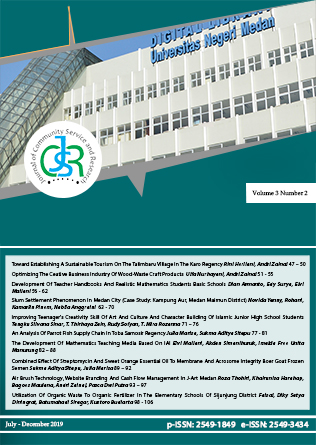THE RELATIONSHIP OF LEARNING INTEREST AND ENGINEERING IMAGES LEARNING OUTCOMES WITH FORMING AND ASSEMBLY LEARNING RESULTS IN CLASS XI METAL FABRICATION ENGINEERING EXPERTISE PROGRAM SMKN 1 LUBUK PAKAM
DOI:
https://doi.org/10.24114/jcrs.v3i2.33038Keywords:
Learning Interests, Learning Outcomes of Engineering Drawings, Learning outcomes of forming and assembling.Abstract
This study aims to determine the magnitude of (1) the relationship of learning interest with learning outcomes of formation and assembly (2) the relationship of learning outcomes of engineering drawing with learning outcomes of formation and assembly, (3) the relationship of interest in learning and learning outcomes of engineering drawing with learning outcomes of shaping and assembly. assembly. The population of this study was students of class XI majoring in Metal Fabrication Engineering at SMK Negeri 1 Lubuk Pakam, amounting to 36 people. Before this research was conducted, the instrument was tested on respondents who were not the research sample, namely the class XI students of SMK Negeri 1 Percut Sei Tuan, totaling 27 people. The research method used is correlational research. The research findings show that: (1) there is a relationship between interest in learning and learning outcomes of formation and assembly with a correlation coefficient of 0.719 with a coefficient of determination of 0.517. This means that 51.7% of learning outcomes of formation and assembly are determined by students' interest in learning. The coefficient of determination is also statistically significant which is indicated by a significance value of 0.000 which is below 0.05. 2) there is a significant relationship between the learning outcomes of engineering drawing and the learning outcomes of forming and assembling with a correlation coefficient of 0.598 with a coefficient of determination of 0.358. This means that 35.8% of the learning outcomes of constructing and fitting are determined by the learning outcomes of technical drawings. The coefficient of determination is also statistically significant which is indicated by a significance value of 0.000 which is below 0.05. (3) there is a relationship between interest in learning and learning outcomes of technical drawing together with learning outcomes of forming and assembly techniques with the regression equation obtained is . The results showed that interest in learning and learning outcomes of engineering drawings had a significant relationship with learning outcomes of forming and assembly techniques. This is indicated by the results of the F test where the calculated F value is 21.021 > 3.28 F table. Thus, there is a positive and significant relationship between interest in learning and learning outcomes of technical drawing together with learning outcomes of forming and assembling students of class XI of the Metal Fabrication skill program for students of SMK Negeri 1 Lubuk Pakam.References
Arikunto,Suharsimi. (2013). Dasar “Dasar Evaluasi Pendidikan.Jakarta: Bumi Aksara
Arikunto,Suharsimi. (2013). Prosedur Penelitian Suatu Pendekatan Praktik. Jakarta: Rineka Cipta.
Departemen Pendidikan Nasional. (2003). Undang-undang No. 20 tahun 2003 tentang Sistem Pendidikan Nasional. Jakarta: Depdiknas.
Dimayati dan Mudjiono. (2013). Belajar dan Pembelajaran. Jakarta: PT Rineka Cipta.
G. Takeshi Sato. (1983). Menggambar Mesin Menurut Standar ISO (diterjemahkan N. Sugiarto Hartanto). Jakarta: PT Pradnya Paramita.
Kemendikbud (2018). Tujuan Smk Sesuai Dengan Kurikulum 2013. Retrieved December 21, 2018 from http://psmk.kemendikbud.go.id
Muhibbin,Syah. (2015). Psikologi Pendidikan dengan Pendekatan Baru Edisi Revisi. Bandung: PT Remaja Rosdakarya.
Purwanto, Ngalim. (2006). Psikologi Pendidikan. Bandung: PT Remaja Rosdakarya.
Sahid Raharjo. (2018). Melakukan Analisis Data dengan SPSS. Retrieved December 21, 2018 from http://www.spssindonesia.com
Sudjana,Nana. (2005). Metoda Statistika. Bandung: Tarsito.
Slameto. (2010). Belajar dan Faktor-faktor yang Mempengaruhi. Jakarta: Rineka Cipta.
Sugiyono. (2008). Metode Penelitian Pendidikan Pendekatan Kuantitatif, Kualitatif, dan R&D. Bandung: Alfabeta.
Downloads
Published
Issue
Section
License
Copyright (c) 2019 Hidir Efendi, Dedi Syahputra

This work is licensed under a Creative Commons Attribution-ShareAlike 4.0 International License.
Authors who publish with this journal agree to the following terms:
- Authors retain copyright and grant the journal right of first publication with the work simultaneously licensed under a Creative Commons Attribution License that allows others to share the work with an acknowledgment of the work's authorship and initial publication in this journal.
- Authors are able to enter into separate, additional contractual arrangements for the non-exclusive distribution of the journal's published version of the work (e.g., post it to an institutional repository or publish it in a book), with an acknowledgment of its initial publication in this journal.
- Authors are permitted and encouraged to post their work online (e.g., in institutional repositories or on their website) prior to and during the submission process, as it can lead to productive exchanges, as well as earlier and greater citation of published work (See The Effect of Open Access).
- This work is licensed under a Creative Commons Attribution-ShareAlike 4.0 International License.
This work is licensed under a Creative Commons Attribution-ShareAlike 4.0 International License.


